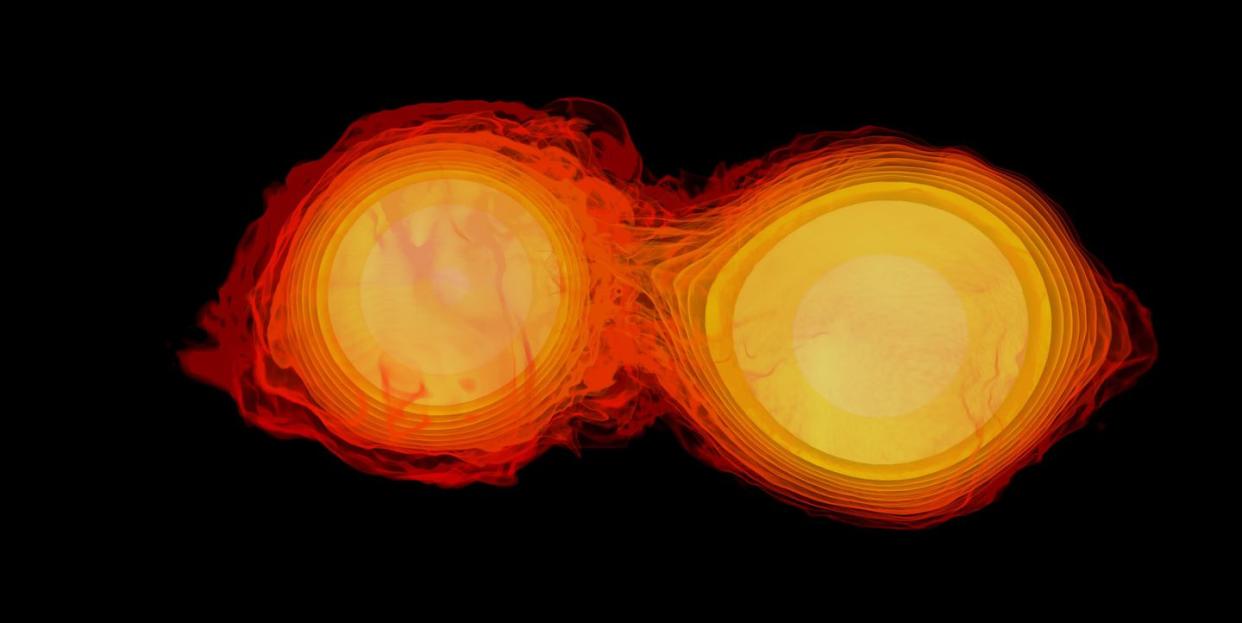Physicists Discovered a Literally Perfect Explosion

Scientists recently discovered that the merger and collapse of two neutron stars makes an almost perfectly spherical explosion.
The blast also has an unexpectedly symmetrical distribution of strontium, a lighter heavy element.
While we don’t yet know why these explosions are so strange, leading explanations include the violent shedding of a magnetic field and neutrinos interfering with element production.
Two stellar remnants slamming together in a violent collision and collapsing into a black hole is, apparently, the recipe for an almost perfectly spherical explosion.
Recently, researchers from the University of Copenhagen re-analyzed data from the first-ever detected kilonova—a massive explosion that occurs when two neutron stars collide, merge, and collapse into a black hole—and found that the explosion was both almost perfectly round and completely symmetrical.
That’s not at all what they expected. The neutron stars that merged to create this explosion are hyper-dense stellar remnants that form when stars about 10 to 25 times the size of our sun go supernova. And before the neutron stars collided, they were rapidly spinning around each other about 100 times every second.
The incredibly fast orbit, combined with some uneven neutrino behavior, lead researchers to believe that the explosion would be more of a lopsided pancake than a nice, symmetrical ball. But the data says otherwise. So, now the question is: why?
In order to have a spherical explosion, the event needed to produce a huge amount of energy from its center. And unsurprisingly, there are already a few theories as to what may have contributed that energy.
One thought is that in the moment the newly-formed hypermassive neutron star collapsed and shed its magnetic field, that field may have released an incredible amount of magnetic energy from the center of explosion and rounded the whole thing out.
But that’s not the only thought, because the shape is not the only mystery. The explosion was also way more symmetrical than expected, down to the distribution of the elements it produced.
Kilonovae are massive production facilities for heavy elements, like gold. Theoretically, lighter heavy elements and heavier heavy elements should have been found in different parts of the explosion. But when researchers looked at the data, they saw strontium, a lighter heavy element, scattered symmetrically throughout the blast.
Thus enters the idea of neutrinos, fundamental particle with no charge at all. A heavy presence of neutrinos can cause all kinds of scientific havoc, partially because they can change neutrons into protons and electrons. This would allow them to change heavy elements into lighter ones, causing a more even distribution of lighter heavy elements throughout the blast.
Even if we don’t yet know why these explosions look the way they do, they might still be very useful. Researchers are proposing that they may be able to serve as an extremely accurate standard candle—an object we use to measure distances in space—due to their bright and spherical nature.
Mostly, though, this discovery demonstrates that there is a lot about kilonovae that we just don’t know. A surprise like this in the world of astronomy means there’s some fundamental physics at play that we don’t yet understand.
And that’s good, because now we get to dig in even further to answer new questions. Hopefully, someday we’ll capture another kilonova in the same level of detail, and we can compare the data on the two explosions. Maybe seeing a few more perfectly round explosions like that will clear things up.
You Might Also Like
